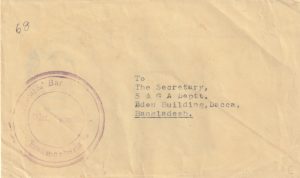Bangladesh
Bangladesh, located in South Asia and bordered by India and Myanmar (Burma), has a rich and complex postal history closely tied to its colonial past and independence struggle. Originally part of British India, the region known as East Bengal used British Indian stamps until the partition of India in 1947, when it became East Pakistan, a province of Pakistan. During this period, Pakistan’s postal authority issued stamps for use in both East and West Pakistan, often featuring symbols of unity that masked the growing cultural and political differences between the two regions.
The journey to Bangladesh’s postal independence began with the struggle for autonomy and recognition of Bengali identity, leading to the Liberation War in 1971. In the early days of the conflict, provisional stamps were issued by Bangladeshi freedom fighters, featuring overprints on Pakistani stamps with “Bangladesh” inscribed in Bengali. These provisional stamps hold significant historical value, as they reflect the determination and resilience of a population fighting for its national identity.
Following its independence on December 16, 1971, Bangladesh issued its first official stamp series in 1973, celebrating the nation’s hard-won freedom and featuring the new flag, emblem, and national martyrs. Over the years, Bangladeshi stamps have honored its natural beauty, culture, and the achievements of its people, with themes ranging from rice cultivation and jute production—staples of its agrarian economy—to landmarks like the Shaheed Minar and the Sundarbans, the world’s largest mangrove forest and home to the Bengal tiger.
Bangladesh’s stamps also commemorate international relations, major historical events, and prominent figures, including the nation’s founding leader Sheikh Mujibur Rahman. As an active member of the Universal Postal Union, Bangladesh has used its philately to emphasize global cooperation and regional alliances, often issuing stamps to commemorate participation in the United Nations, SAARC, and other international bodies. Today, Bangladesh’s vibrant stamp issues continue to reflect its evolving national identity, cultural heritage, and development journey in one of the world’s most populous and resilient nations.




